Lighting for seedlings can be a complicated and intimidating topic, but it doesn’t have to be. Once you learn about when and how to use them, you’ll find that it’s much easier than you think.
Don’t worry, I’m not going to get super technical on you here, I want to make this very easy. Below I will break it all down so you don’t get overwhelmed.
In this post, you’ll learn everything you need to know about using grow lights for seedlings. Including whether or not you need them, the best types to use, when to turn them on and for how long, how set them on an automated schedule, and much more.
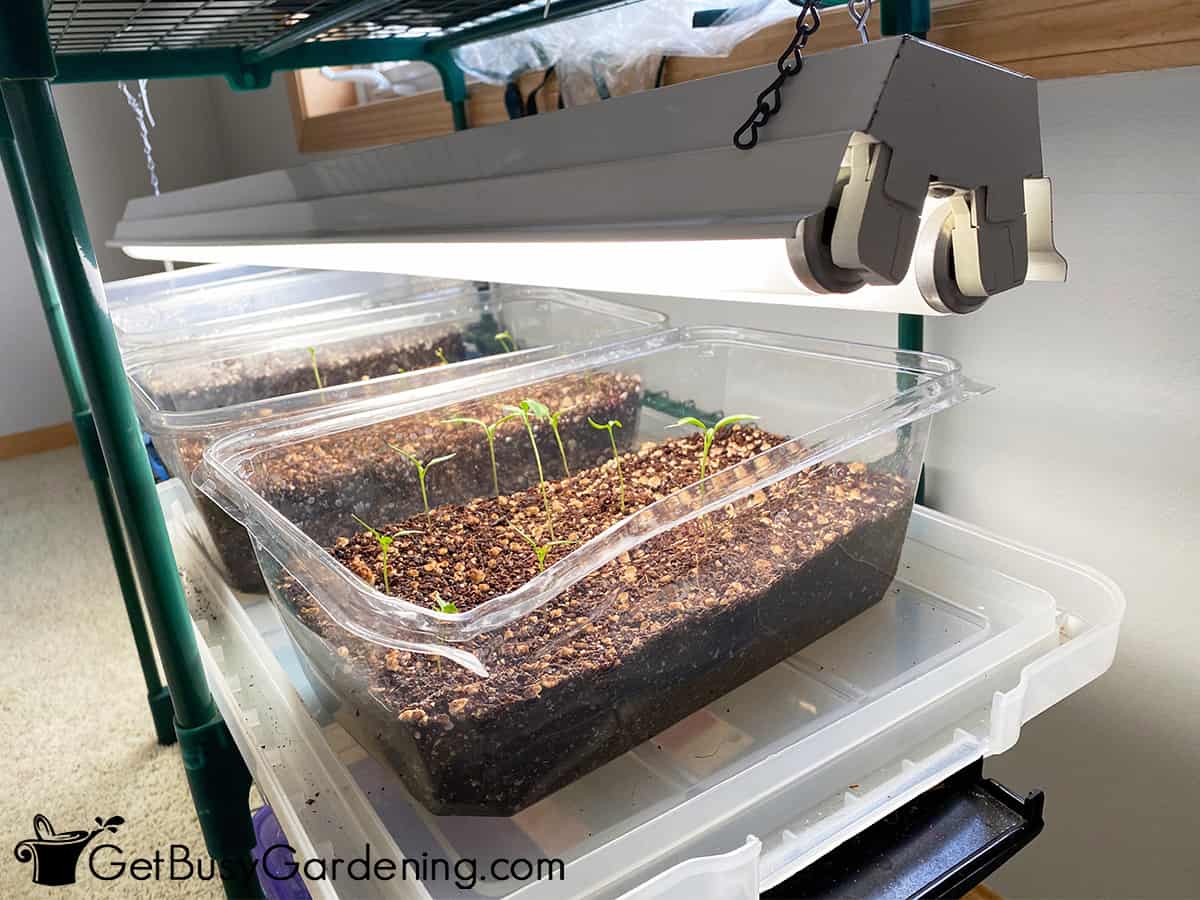
Why Use Artificial Light For Seedlings?
Adequate lighting is a key part of successful seedling care, and it will help give them a good start to life. When they don’t get enough, they become tall, weak, and leggy, and may not survive for very long.
I’ve been growing seeds indoors for well over 20 years, and I’ve learned why this is so important from trial and error.
My Story
I didn’t use grow lights on my seedlings for the first few years because I have a large south-facing window in my spare bedroom. I set up shelves right in front of it, and that worked ok. But my seedlings were always thin and looked unhealthy compared to the ones I saw at the store.
Things got worse for me once I started to experiment with different types of seeds, and some would stretch so far towards the window that I had no choice but to toss them out.
That’s when I realized I was wasting a lot of time and money (and heartache) just to save a few bucks. So I decided to buy myself some grow lights, and I was amazed at what a difference it made. I was sold!
Not only did my seedlings look fantastic, but supplementing with artificial lights meant I didn’t need to plant as many seeds. That’s because they were much healthier and stronger, I never had to throw any of them into the trash again.
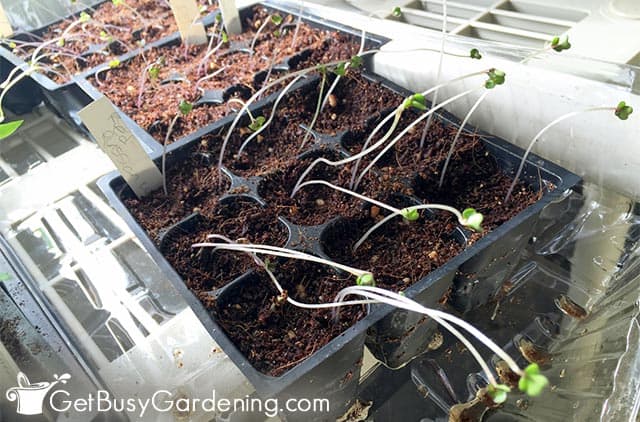
Do Seedlings Need Grow Lights?
The short answer to this questions is yes. Seedlings need artificial light indoors to grow as strong and healthy as possible, and it’s important to provide it right from the start. That being said, you don’t absolutely need to buy them.
If you’re a beginner, and you don’t want to invest the money up front, you can use a sunny window. Or better yet, if your home has a porch, patio, or another space that’s filled with natural sunlight, then try that and see how well it works for you.
But once you have a few flats going, and you know you’re in it for the long haul, I definitely recommend investing in proper lighting for your seedlings. They’ll end up paying for themselves in a short time.
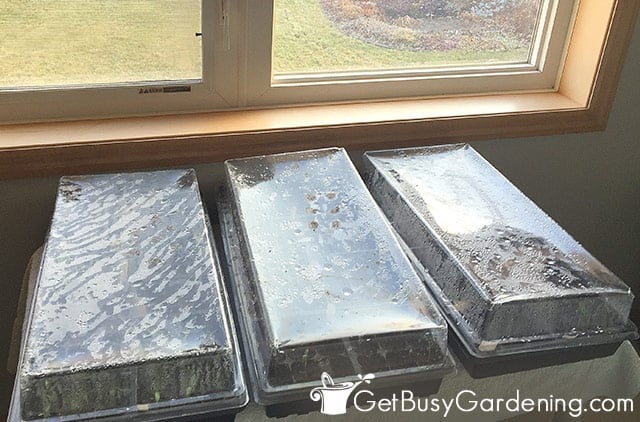
Benefits
There are tons of benefits to using the proper lighting for seedlings. Below I’ve listed the main ones, so you can see why it’s so important:
- Stronger and healthier seedlings – The main benefit of using artificial lights is that your seedlings will be much stronger, healthier, and stay more compact than they would in a sunny window.
- Better survival rate – Once you provide enough light, you’ll find that the survival rate of your seedlings is much higher, and you’ll be so much happier with the outcome.
- Less waste – Since you won’t have to plant extras to make up for those losses, there will be much less waste. You won’t waste any seeds or dirt… or your time. Because of this, you’ll find the lights will pay for themselves pretty quickly.
- Much easier – Getting them on an automated schedule will make your life so much easier too. By using a timer, you can just set it and forget it, rather than having to constantly monitor and rotate your trays.
- Prevents legginess – Providing adequate lighting is the only way to prevent seedlings from getting tall and leggy.
- Grow seeds anywhere in your house – Since you won’t have to worry about keeping them in a room that gets tons of natural sunlight, you can grow your seedlings anywhere in the house.
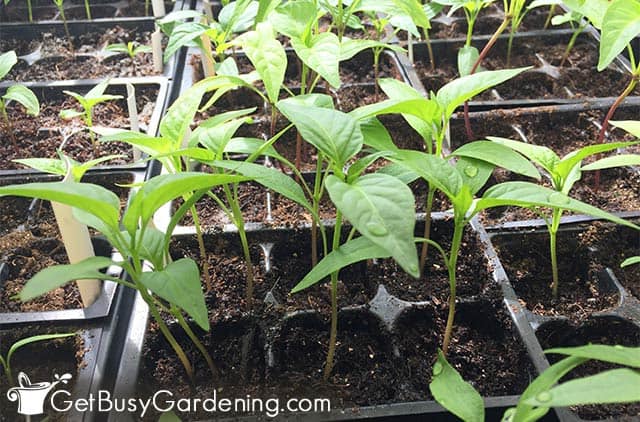
Best Grow Lights For Seedlings
It’s very important to make sure that you use the right kind of grow lights for your seedlings. Some types, like regular incandescents, for example, are way too hot, and will only end up frying the tiny starts. Here are the best ones to use:
- Plant grow bulbs – Your first option, which also tends to be the cheapest, is to buy plant grow bulbs. You can find them for sale just about anywhere these days. They come in standard sizes that are made to fit into any fixture that you already have.
- Fluorescents – Another great option is to use standard cool-white fluorescent bulbs. I made my own seedling grow lights using a standard shop fixture and fluorescent bulbs. Get the step by step instructions here.
- LED grow lights – If you don’t want to mess around with assembling your own, or you’re not sure how or where to hang them, then I recommend getting a full system like this 4′ LED setup. Or something smaller like this one that’s 2′ long.
- T5 grow lights – Another great option is T5 grow lights. Here’s a 2′ long one that I recommend, otherwise that same one also comes in an 18″ length if you need something longer.
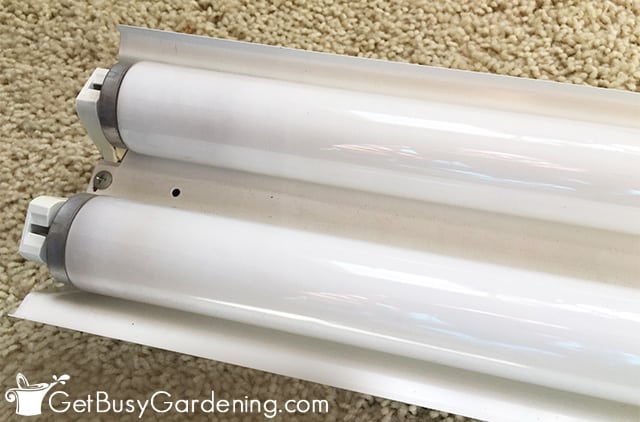
How Much Light Do Seedlings Need?
Understanding how much light seedlings require is just as important as choosing the right bulbs. So in this section, I’ll tell you exactly how many hours they need, and give you examples of the best schedule to keep them on.
Number Of Hours
Seedlings need 12-16 hours of light every single day, without fail. The reason this is a broad range is that some types need more than others do.
If you’re new to this, I recommend you start by keeping them on for 14 hours a day. Then monitor your seedlings closely. If they start getting tall, stretching, or growing sideways, bump it up to 16 hours per day.
On the other hand, if they are staying compact and thick, then you can turn it down to 12 hours to save some energy, and see how well they do with less light.
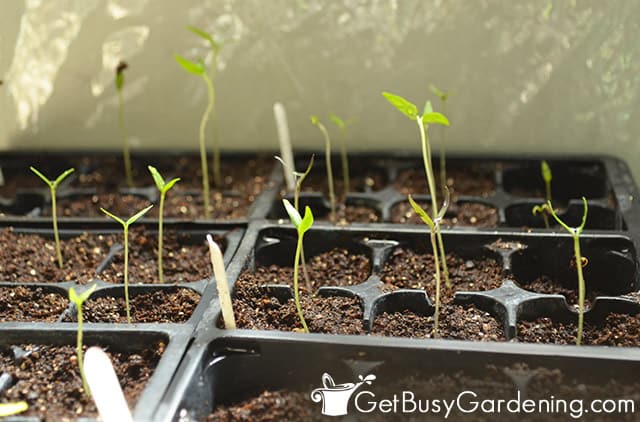
Best Lighting Schedule To Use
It’s important to stick to a strict schedule – consistency is important for uniform growth. So I highly recommend using an inexpensive outlet timer to keep it the same every day.
Some people like to follow a 12/12 lighting cycle for their seedlings. That means the bulbs stay on for 12 hours during the day, and they are off for 12 hours at night.
But in my experience, that’s not long enough, so I prefer running mine for 14-16 hours daily. I set my timer on a schedule to turn them on at 6:00am every morning, and to turn them off at 10:00pm each night.
If for some reason that doesn’t work for you, you could do a 7am to 9pm schedule, or something similar. The exact times don’t matter so much, as long as the schedule stays the same.
When Do I Put My Seedlings Under Light?
You should put your seedlings under light as soon as the first one germinates (starts to sprout). They grow very fast, and will begin stretching right away – even as they’re still emerging.
It’s important to note that some types of seeds need light to germinate. So, if that’s the case with any of yours, then you should put them under there right after you plant them.
Related Post: How To Fix Common Seedling Problems
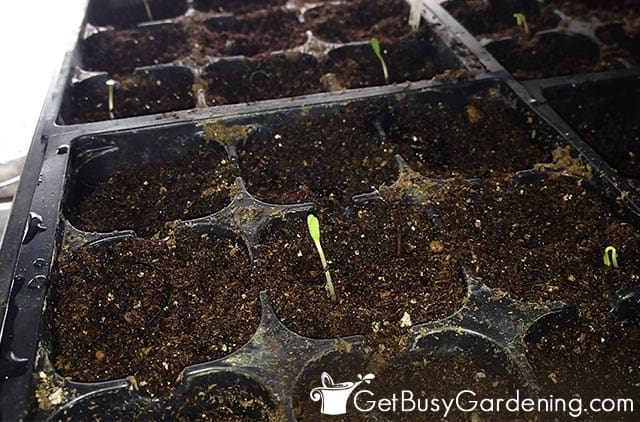
How High To Hang The Lights
To be effective, the grow lights need to be fairly close to your seedlings. You should keep them 2-3″ above the tops of the leaves at all times. If yours have an adjustable intensity setting, you can turn that up and move the fixture higher (6-12″ above, depending on how strong the intensity is).
You’ll need to adjust the height on a regular basis as your starts get taller. The leaves should never touch the bulbs, or they could burn.
So make sure to check on them every day, and move the lights up as necessary. Using an adjustable hanger will make this job a whole lot easier.
If you need them for germination, or the lids are still on your trays, then hang them directly above (but never touching) the plastic.
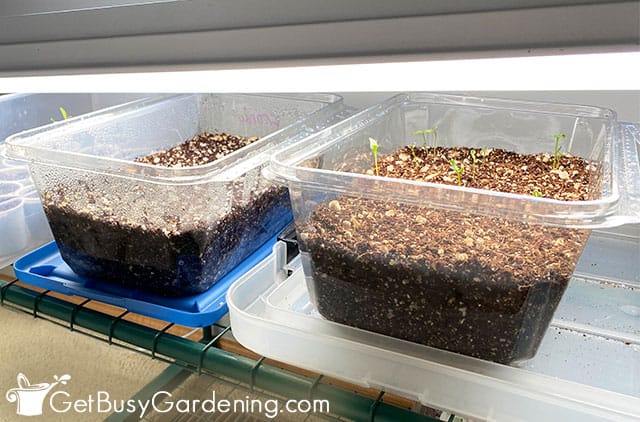
When To Turn Off Your Grow Lights
As long as your seedlings are indoors, they should be under the grow lights. The only time you should remove them or turn them off is when you put your seedlings outside.
Once you begin to harden your seedlings, you can turn off the lights while they are outdoors. But, you should always put them back right away whenever you bring them inside, or they will quickly start getting leggy.
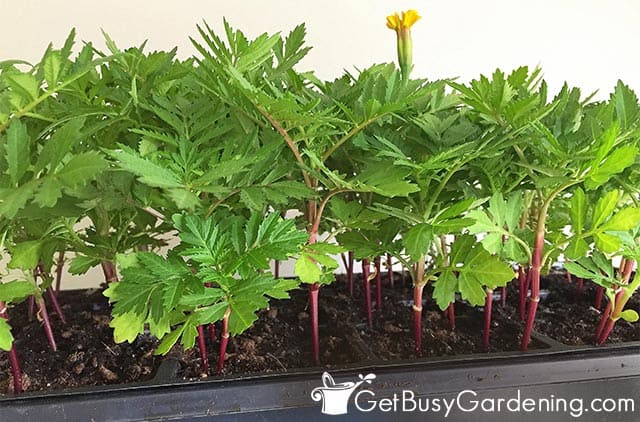
FAQs
No, and you should not put seedlings under grow lights for 24 hours a day. It’s important to follow the normal pattern of the sun, or your seedlings will suffer when it’s time to move them outside. Just like us, they need darkness at night to rest. So keep them on during the day, and turn them off at night.
If you provide the proper lighting for seedlings, then you should not need to rotate them. However, many times the trays are wider than the lamp fixture. So, you may notice some of the ones around the outside edges will start reaching. In that case, it’s best to rotate them daily to ensure even growth.
Yes, you certainly could try starting your seeds indoors without grow lights. However, most homes do not get enough sun for healthy seedling development. So, for the best results, I recommend supplementing with artificial ones.
Some types of seeds do need light to germinate, but others do not. Always check the packet for details, or research the specific varieties before planting them.
Adequate lighting is extremely important for success with seedlings, and it will give them a healthy start to life. Plus you’ll find that it makes your job much easier, with less waste and frustration.
If you’re new to starting seeds, and you want to learn everything you need know in order grow your garden from seed, then you should enroll in my Online Seed Starting Course. This self-paced course will walk you through it all, step by step. Enroll and get started right now!
Otherwise, if you just need a refresher, or you want a quick-start guide, then my Starting Seeds Indoors eBook is just what you need.
More Posts About Seedlings
Share your tips about using artificial lighting for seedlings in the comments below.
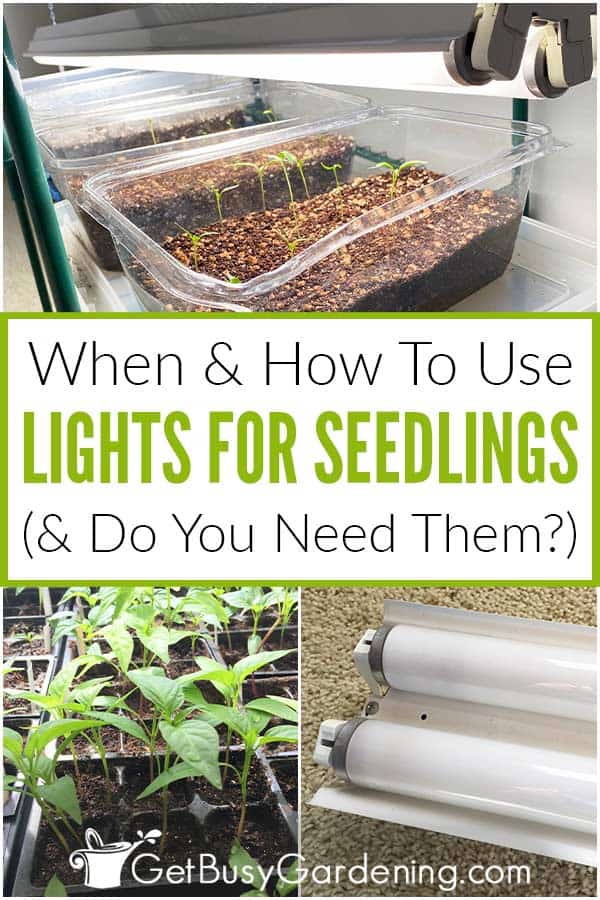
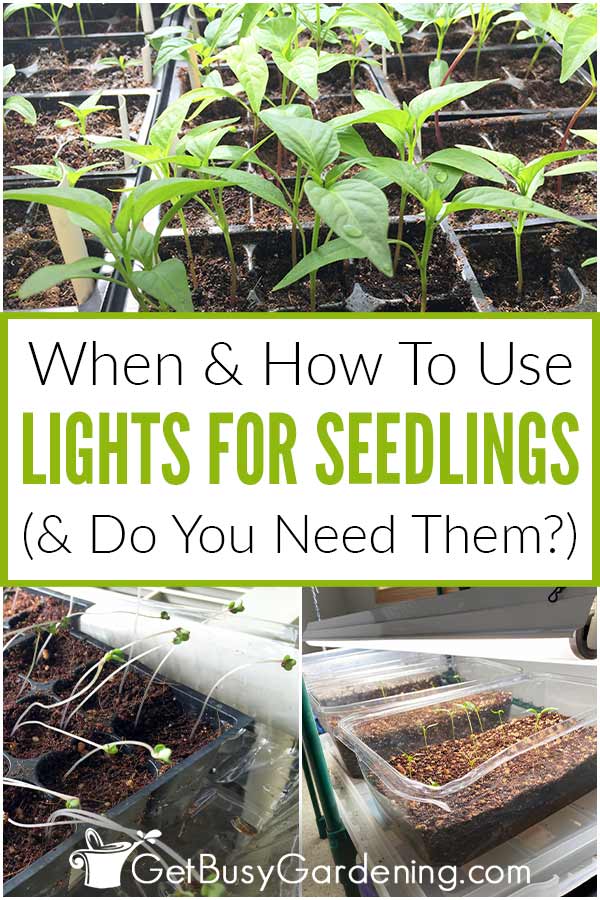
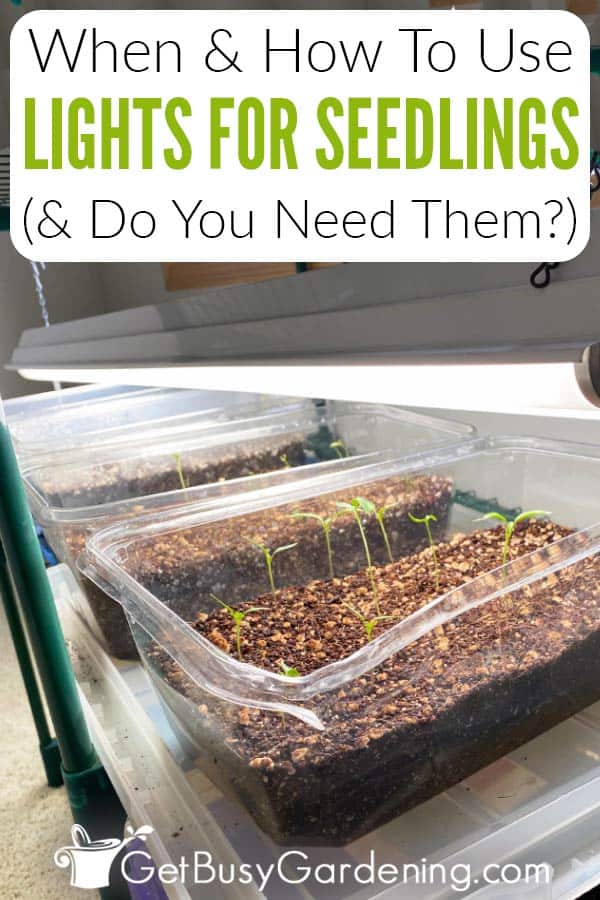



Jean p says
I live in nj and want to plant seedlings during winter. If i time right i can move them outside when no threat if frost. My question is if i griw seedlings on my enclosed porch, which is not heated, will it be safe for seedlings and how much light should it get from heat lamps?
Amy Andrychowicz says
Your unheated porch would be the perfect place to harden your seedlings once it’s warm enough outside. But it won’t be warm enough during the winter to grow your seeds.
John says
Have you tried doing Cantaloupes indoor? what is the light requirements?
Amy Andrychowicz says
Cantaloupe seedlings need a lot of light to prevent them from getting leggy. Turn on your grow lights as soon as you see sprouts, hang them only a few inches above the seedlings at all times, and keep them on for at 16 hours/day or more.
A Roberts says
Are 55 lumens/ 3000K Puck lights 2-3″ above good for starting and growing microgreens from seed indoors?
I have small shelf units (6″x8″ and 2″x3″) that I would like to grow microgreens on and also to start veg seedlings indoors in prep for spring. I plan to attach the Above-described Puck lights 2-3″above little grow containers w seeds to germinate and grow.
Amy Andrychowicz says
I have never tried using puck lights, but they may work for you. I would definitely recommend using several of them, and spacing them maybe like 4-6 apart so you have good coverage. Watch your seedlings closely from the start. If they begin to stretch or reach for the window, then you need to add more lights.
DAVID DODD says
In south Florida we start our seedling in pots in late summer and leave them outside. My question is will I need to supliment the natural outdoor light since daylight hours are only about 10 each day.
Amy Andrychowicz says
You shouldn’t need to supplement the lighting for your seedlings outdoors, the sunlight is definitely much stronger outside than it is inside the house.
Vicki Ramsay says
I’m curious what you think about regular fluorescent lights that are found in typical school/office buildings. Last year was the first year I relied on these lights for my seedlings and they just seemed tiny, delicate, and a bit anemic compared to those I had grown in a greenhouse. Many of them didn’t thrive in the garden, although some did. This year, I bought two grow lights, but if I want to have all my seedlings under proper lights, I will need to buy more. Could I just buy replacement bulbs for the light fixtures? They would be very high then, and not adjustable, and would maybe get leggy anyway. Any advice would be appreciated! Thanks!
Amy Andrychowicz says
It is best to use plant grow light bulbs rather than regular fluorescent lights for your seedlings. However, regular fluorescent lights can work. The most important part is to make sure the lights hang directly above the seedlings (as close as possible without touching the leaves), and you keep them turned on for 14-16 hours every single day. If your grow light fixtures aren’t adjustable, then you can either buy an adjustable hanger (which I link to in the article), or try making your own custom stand (you can modify my design to fit your needs).
Sam says
First year germinating from seed. I started my seedlings about 4 weeks ago, and only now noticed my timer hasn’t been working. So my vegetable plants have been getting 24/7 grow light since they were first planted. I’m seeing all over that 24/7 light is not good for the plants and that they need a rest cycle. Am I able to save them by giving them a proper light cycle for the last few weeks until I harden them for transplanting outside?
Or will they just not survive because of too much growth?
Amy Andrychowicz says
No worries, just set the timer to the proper light cycle, and the seedlings should adjust fine.